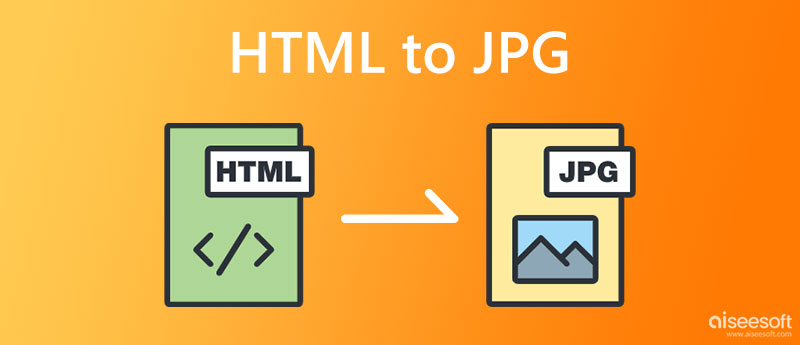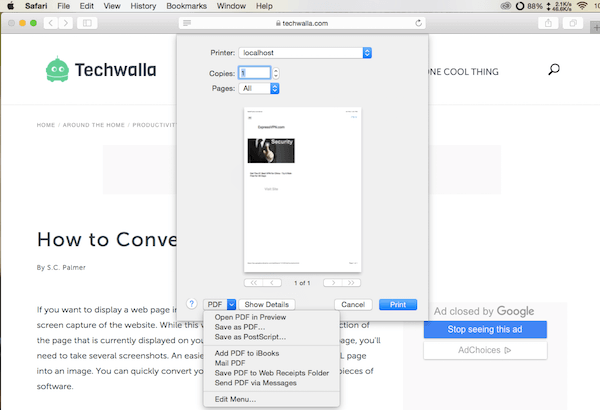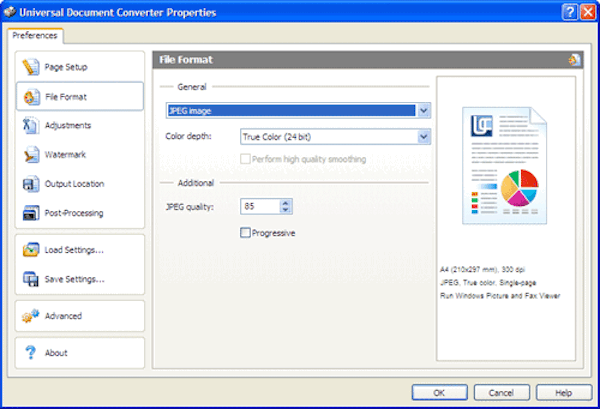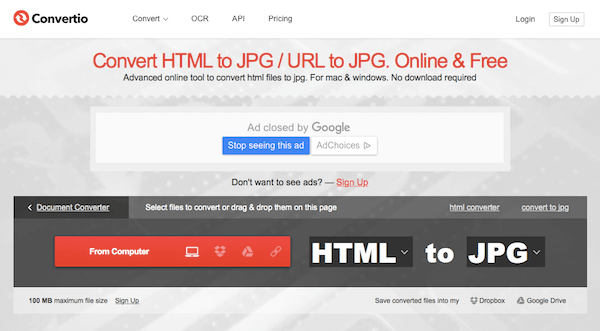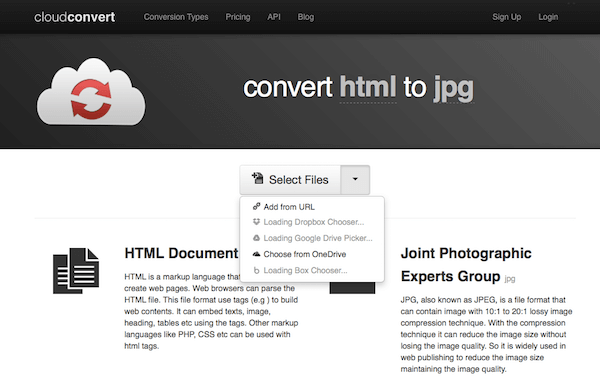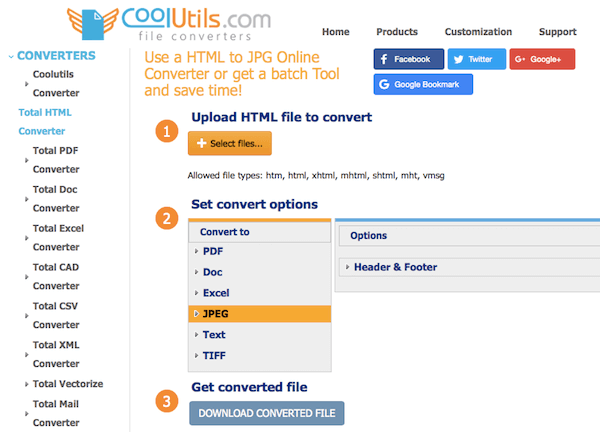html в jpg php
Convert HTML to PNG or JPG in PHP [duplicate]
I have a DIV element with some images positioned within the DIV element. I want to make a JPG or a PNG file out of that, so people can save it for their Facebook timeline cover image. I found a LOT of scripts and tutorials, but nothing really fills my needs. This can’t really be a very hard thing to do?
I already got my host to install iMagick.
3 Answers 3
You should get the positions via JavaScript (I guess you are using js to set the positions of the images in the div) and send them to a PHP-Script. With help of the PHP GD manual you can easily generate a png oder jpeg image.
I had to achieve the same thing, only for something else than Facebook and I used webkit2png
I save the HTML code on a temporary HTML file, then I run the python webkit2png command on that temporary HTML file which converts it to PNG. It requires xvfb (apt-get install xvfb)
I then use the following command in PHP:
Not the answer you’re looking for? Browse other questions tagged php or ask your own question.
Linked
Related
Hot Network Questions
site design / logo © 2021 Stack Exchange Inc; user contributions licensed under cc by-sa. rev 2021.9.16.40232
By clicking “Accept all cookies”, you agree Stack Exchange can store cookies on your device and disclose information in accordance with our Cookie Policy.
imagejpeg
(PHP 4, PHP 5, PHP 7, PHP 8)
imagejpeg — Выводит изображение в браузер или пишет в файл
Описание
Список параметров
Возвращаемые значения
Возвращает true в случае успешного выполнения или false в случае возникновения ошибки.
Список изменений
| Версия | Описание |
|---|---|
| 8.0.0 | image теперь ожидает экземпляр GdImage ; ранее ожидался ресурс ( resource ). |
Примеры
Пример #1 Вывод JPEG-изображения в браузер
// Устанавливаем тип содержимого в заголовок, в данном случае image/jpeg
header ( ‘Content-Type: image/jpeg’ );
Результатом выполнения данного примера будет что-то подобное:
Пример #2 Сохранение изображения JPEG в файл
Пример #3 Вывод JPEG-изображения с 75% качеством в браузер
// Устанавливаем тип содержимого в заголовок, в данном случае image/jpeg
header ( ‘Content-Type: image/jpeg’ );
Примечания
Если требуется вывести Progressive JPEG (прогрессивное представление данных), то необходимо использовать функцию imageinterlace() для активации соответствующего режима.
Смотрите также
User Contributed Notes 34 notes
I didn’t find any example like this on the Web, so I mixed pieces together.. hope this will save time to other people!
Here’s a complete solution to READ any image (gif jpg png) from the FILESYSTEM, SCALE it to a max width/height, SAVE the scaled image to a BLOB field keeping the original image type. Quite tricky..
/*
* imageXXX() only has two options, save as a file, or send to the browser.
* It does not provide you the oppurtunity to manipulate the final GIF/JPG/PNG file stream
* So I start the output buffering, use imageXXX() to output the data stream to the browser,
* get the contents of the stream, and use clean to silently discard the buffered contents.
*/
ob_start ();
?>
So, let’s suppose you have a form where a user can upload an image, and you have to scale it and save it into your database.
[..] // the user has clicked the Submit button..
[[Editor’s note: removed the header()-call since it is not required when outputting inline image-data]]
One single code line, solve-me after 3 hours of blind search!
echo » «; //saviour line!
I worked out a script that allows the transfer of alphanumeric data to be placed on an image. The HTML feature is img src and the php feature is imagettftext. This simple code will increment from 1 to 3 on images.
Regarding Carl Gieringer’s comment, it is possible to have PHP files in utf-8. Just make sure the editor does not output BOM, which is unnecessary in utf-8 anyway.
Except for any editors from Microsoft, most programmer’s editors that supports utf allows you to surpress BOM.
With regard to chris.calo’s code:
It assumes more than that, namely that the filename does not contain the strings ‘.gif’, ‘.jpg’, ‘.jpeg’, ‘.bmp’, or ‘.png’ *anywhere* in the string. Some valid files with special filenames could break this; for example, a file named «used.to.be.a.png.file.gif» would cause this script to attempt to load the file as a PNG. Obviously this is a rare case, but the issue could be easily avoided by using «else ifs» (uses less CPU time) or checking that the extension abuts the end of the string or both.
That said, the whole business could be avoided if PHP didn’t clutter the namespace with different functions to do the same thing with different image formats. Ick.
note below is missing «()» from the ob_end_clean call:
ob_end_clean; // stop this output buffer
ob_end_clean(); // stop this output buffer
You can then use this for adding content-length headers (for example flash requires a content length in advance to create loaders)
For those looking to grab the resolution of a JPEG image without using GD nor ImageMagic. I wrote this simple function.
Too bad GD doesn’t have this very simple function for us to use.
I had a problem with denied permissions when trying to upload AND resize an image having safe_mode on. This caused that I couldn’t create the new file in which I wanted to resampled the image with nor with imagejpeg() nor with touch() and imagejpeg() after it.
Here is my solution, I didn’t test, but it’s possible, it is biting some memory:
?>
As you can see, the function moves the uploaded file where you want to save the resampled image (move_uploaded_file is not restricted by safe_mode) and then you can resample the image, because it was created by moving it already.
Note: the directory where you want to save the file must have permissions set to 0777.
Anything over 80 results in an unnecessary increase in file size without much increase in image quality.
I had similar problem with safe mode. My solution is:
before imagejpeg(), touch() etc.
write:
ini_set(safe_mode,Off);
and after everything:
ini_set(safe_mode,On);
strange, but it works
Chears2All
If you wish to capture the jpg data into a variable, rather than outputting it or saving it into a file (perhaps so you can put it in a database), you might want to consider output buffering. Something along these lines should work:
I came here looking for something similar to the getJPEGresolution function, but noticed the drawbacks that were pointed out in the last post. So, after drawing on some other code examples on the web, I put together the following function which should always properly return the correct values. (But remember that you still need to have the EXIF extension installed with your instance of PHP for this to work!)
?>
This function returns an array with the x-resolution, y-resolution when they can be determined, otherwise FALSE.
Take to heart that CAUTION note on this function. If gdlib fails to output, it still returns true! I’d call that a bug personally.
GD will fail to output if you have an image exceeding its maximum undisclosed dimensions of 65500 pixels.
You’ll get a zero byte file instead
Here is a function to resize an image and maintain aspect ratio. It will resize jpeg, gif or png and could easily be modified to add bmp. The name field is the destination of the file minus the file extension:
Please note that there is a bug report open for the currently broken safe_mode behaviour on this function:
According to the PHP staffer who has responded the docs are wrong (I don’t agree but I’m also not their employee).
The work around is to use touch() (or any other file system function that can do this) to create the file first before using imagejpeg().
A word of warning when outputting images to the browser.
Make sure there is no extra spaces around the tags, in the file you are editing, and also any included files.
I began to think there was a bug in GD or something, and I checked the file I was working on, but forgot about the includes.
Rather than using the temporary file, as described above, you can buffer the output stream. Someone else showed me this, and it seems to work very nicely.
//Start buffering the output stream
ob_start();
// output the image as a file to the output stream
Imagejpeg($im);
//Read the output buffer
$buffer = ob_get_contents();
//clear the buffer
ob_end_clean();
[Editor’s note: fixed according to the note of roberto at ilpiola.it]
// Change DPI
$dpi_x = 150 ;
$dpi_y = 150 ;
Don’t forget that JPEG compression has artifacts! And they’re not all really obvious. The PHP JPEG compression is pretty decent, but it seems to generally:
-Lighten the image overall, by a reasonable amount (never seen this before, but it will drive graphic designers crazy, you might want to darken the image before compressing it)
-Reduce saturation, especially with images with lots of points of different color within a few pixels of each other (this is a documented feature of JPEG)
-Seriously mess with blue colors, which is common to all JPEG but really annoying in some situations with blue and black or other detailed blue parts
You might want to consider using imagepng() and outputting a PNG image instead of a JPEG if any of the above affect you, or your image is not very photo-like. Sometimes I have an algorithm compare JPEG to PNG for an image and send the smaller version to the user.
Also, when using imagepng(), you should use imageinterlace() before it 95% of the time. Interlaced JPEGs load progressively, improving in quality as the image loads, so users on slower connections see the whole image at low quality. All this happens without affecting the file size (actually, sometimes the file size is smaller!) or final quality.
Hope this helps a few people out. It’s not all that obvious without lots of playing around.
Don’t be like me racking my brain for hours trying to figure out why my xxx.php file outputs http://localhost/xxx.php as a one line response.
Most likely, you have either:
1. whitespaces before or after the php tags
2. need to set header(‘Content-type: image/jpeg’);
3. if you have required files. be sure nothing is outputted. no test print statements because page expects image information
4. there is an error in your code
in my case, it was 4. there is a reason why the function call base64decode does not work.
it’s actually: base64_decode()
by the way, other ways to validate your image encoded in base64 is to use the following tag:
I was pulling a blob encoded base 64 data from mysql database and trying to render it on a page
hope this helps someone.
Here’s another on-the-fly thumbnail creation script.
When I scripted the pictuerviewer on my page, I had all the pictures only in full size and qualit, because I wanted the posibility für visitors to download the pictures.
But as Imagesizes of more than 4 MP are to large for websites, I created thumbnails and the smaller pictures on the fly. But I found out, that the Script needed too much RAM, especially in the thumbnail overview, when I had more then 50 thumbnails to create on the fly at the same time.
So I modified my image creator and my viewer to let them store images, that are created. So only the first visitor has to wait (which is usually me for controlling the uploads und updates), all other visitors get the stored images, which is much faster.
Create different folders. I have a main folder called ‘imagesdb’ and the tree subfolders full (Full quality images), show (images for the picture viewer) and thumb (for thumbnails in overview).
Store the script for example as image.php and link it like that:
// Now set the maximum sizes to the different styles.
// You may set additional styles, but remember to
// create the according subfolders.
header ( «Content-type: image/jpeg» );
?>
As this website helped me for several times in the past and for creating this script, I hope I can help others with this script saving the time for developing a much more performant solution than an allways-on-the-fly-creating script.
imagejpeg — Выводит изображение в браузер или пишет в файл
Описание
Список параметров
Необязательный параметр, и может принимать значения в диапазоне от 0 (низкое качество, маленький размер файла) до 100 (высокое качество, большой размер файла). По умолчанию используется качество IJG (около 75).
Возвращаемые значения
Возвращает TRUE в случае успешного завершения или FALSE в случае возникновения ошибки.
Примеры
Пример #1 Вывод JPEG-изображения
// Устанавливаем тип содержимого в заголовок, в данном случае image/jpeg
header ( ‘Content-Type: image/jpeg’ );
Результатом выполнения данного примера будет что-то подобное:
Пример #2 Сохранение изображения JPEG
Пример #3 Вывод JPEG-изображения с 75% качеством
// Устанавливаем тип содержимого в заголовок, в данном случае image/jpeg
header ( ‘Content-Type: image/jpeg’ );
Примечания
Замечание: Поддержка JPEG доступна только в случае, если PHP был скомпилирован с GD-1.8 или более поздней версии.
Если требуется вывести Progressive JPEG (прогрессивное представление данных), то необходимо использовать функцию imageinterlace() для активации соответствующего режима.
Смотрите также
5 полезных методов для преобразования HTML в JPG
Что вы будете делать, если хотите отобразить свою любимую веб-страницу? Просто сделайте снимок экрана веб-страницы или конвертируйте этот HTML в другие форматы?
Как вы знаете, вы можете захватить только ту часть веб-страницы, которая в данный момент отображается для вас, тогда как вы не можете захватить другую часть. Если вы хотите сохранить всю страницу, рекомендуется конвертировать HTML в другие форматы, такие как JPG.
Для тех, кто не знает, как конвертировать HTML в JPG, вы можете просто прочитать и следовать этой статье, чтобы получить эти полезные методы для преобразования HTML в JPG.
Часть 1. Что такое HTML-документ
HTML, также называемый Hypertext Markup Language, является стандартным языком разметки, который используется для создания веб-страниц. Вообще говоря, документы HTML принимаются веб-браузерами с веб-сервера или локального хранилища и преобразуются в мультимедийные веб-страницы. Но если вы хотите отобразить HTML-файл на других устройствах, таких как мобильный телефон, iPad, гораздо удобнее конвертировать HTML-файл в другие форматы, а затем делиться этим файлом.
Часть 2. Как конвертировать HTML в JPG на вашем компьютере
Метод 1: Как конвертировать HTML в JPG с помощью браузера
Вы можете просто конвертировать HTML в JPG с помощью браузера и программного обеспечения для редактирования изображений. Просто прочитайте следующие подробные шаги и начните конвертировать HTML в JPG самостоятельно.
Шаг 1 Во-первых, вам нужно открыть HTML, который вы хотите конвертировать в вашем браузере.
Шаг 2 Нажмите на кнопку Файл, которая находится на верхней панели инструментов. И затем выберите Print, который находится в списке файлов. И тогда появится окно параметров печати.
Шаг 3 Нажмите на кнопку PDF, которая находится в настройках печати. И затем выберите Сохранить как PDF. После выбора имени файла ваш браузер сохранит этот новый преобразованный файл.
Шаг 4 Теперь откройте файл PDF в программе для редактирования изображений, такой как Photoshop или GIMP. Затем выберите «Файл» на панели инструментов и выберите «Сохранить как», выберите «.jpg» в качестве выходного формата. После нажатия на кнопку «Сохранить», вы получите новый файл JPG.
Способ 2: Как конвертировать HTML в JPG с помощью универсального конвертера документов
Вы также можете использовать Universal Document Converter для конвертации HTML в JPG. Это профессиональное программное обеспечение, вы можете просто сделать это преобразование. Просто следуйте следующим шагам.
Шаг 1 Загрузите программное обеспечение Universal Document Converter на свой компьютер. После установки запустите его.
Шаг 2 Откройте файл HTML, который вы хотите преобразовать в Internet Explorer. Затем выберите «Сервис»> «Свойства обозревателя»> «Дополнительно». Далее в разделе «Печать» установите флажок «Печать цветов фона и изображения». Нажмите на ОК.
Шаг 3 Нажмите кнопку «Файл» и выберите «Параметры страницы». Далее вам нужно удалить любой текст из верхнего и нижнего колонтитула. Нажмите на ОК.
Шаг 4 Снова выберите кнопку «Файл» и нажмите «Печать». Затем выберите «Универсальный конвертер документов» в окне «Печать», затем нажмите «Настройки».
Шаг 5 Нажмите «Загрузить свойства» и используйте диалоговое окно «Открыть», чтобы выбрать веб-страницу для PDF.xml, затем нажмите «Открыть».
Шаг 6 На вкладке «Формат файла» выберите изображение JPEG и нажмите «ОК». Затем нажмите кнопку «Печать» еще раз, чтобы начать преобразование HTML в JPG. И он будет сохранен в папке «Мои документы \ Выходные файлы УДК» по умолчанию.
Часть 3: Как конвертировать HTML в JPG онлайн
Способ 1. Как конвертировать HTML в JPG Online с помощью Convertio
Шаг 1 Найти конвертирование HTML в JPG онлайн-конвертер с вашим браузером.
Шаг 2 Выберите файлы HTML, которые вы хотите конвертировать, нажав «С компьютера». Вы также можете добавить файл из Dropbox, Google Drive, URL или просто перетащить их на эту страницу.
Шаг 3 Вам не нужно выбирать HTML в качестве формата ввода и JPG в качестве формата вывода. Просто начните это преобразование HTML в JPG. И вы также можете сохранить преобразованные файлы в свой Dropbox или Google Drive.
Способ 2: Как конвертировать HTML в JPG онлайн с CloudConvert
CloudConvert также предоставляет вам функцию преобразования HTML в JPG. И это позволяет вам добавить свой HTML-файл из разных мест.
Шаг 1 Откройте CloudConvert HTML в JPG онлайн-конвертер в вашем браузере.
Шаг 2 Нажмите на кнопку «Выбрать файлы», а затем добавьте свой HTML-файл, который вы хотите конвертировать из URL, Dropbox Chooser, Google Drive или других.
Шаг 3 Этот онлайн-конвертер уже выбрал HTML в качестве входного формата и JPG в качестве выходного формата для вас. Просто начните конвертировать HTML в JPG.
Способ 3: Как конвертировать HTML в JPG онлайн с CoolUtils.com
Также рекомендуется использовать CoolUtils.com для конвертации HTML в JPG онлайн. Всего несколькими щелчками мыши вы можете получить нужный файл JPG. Выполните следующие шаги для преобразования HTML в JPG с CoolUtils.com сейчас.
Шаг 1 Сначала откройте этот онлайн-конвертер или просто найдите coolutils.com в вашем браузере.
Шаг 2 Нажмите кнопку + Выбрать файлы…, чтобы загрузить HTML-файл, который вы хотите преобразовать.
Шаг 3 Теперь вам нужно установить параметры конвертации. Выберите JPEG в качестве выходного формата, а затем установите другие параметры, как вы хотите.
Шаг 4 Просто нажмите кнопку «Загрузить преобразованный файл», чтобы начать преобразование HTML в JPG и загрузить преобразованный файл.
Заключение
В этой статье мы представили вам 5 лучших способов конвертации HTML в JPG. Все способы просты в использовании и могут помочь вам успешно конвертировать HTML в JPG, если вы будете следовать этим инструкциям шаг за шагом. Надеюсь, что вы можете получить что-то полезное из этой статьи.
Что вы думаете об этом посте.
Рейтинг: 4.7 / 5 (на основе рейтингов 15)
10 мая 2018 15:00 / Автор: Дженни Райан в Фото
Как можно объединить несколько видеофайлов MP4 онлайн без установки? В этой статье вы найдете лучший ответ и конкретное руководство, которое поможет вам получить желаемое.
Как обрезать видео на iPhone? Эта статья знакомит вас с 6 лучшими приложениями для обрезки видео, чтобы легко обрезать / обрезать / обрезать видео на iPhone.
Что такое AVS Video Editor? Эта статья знакомит вас с лучшим редактором AVS Video Editor и другими альтернативами для удобного редактирования видео.
HTML to JPG Converter
CloudConvert is an online document converter. Amongst many others, we support PDF, DOCX, PPTX, XLSX. Thanks to our advanced conversion technology the quality of the output will be exactly the same as if the file was saved through the latest Microsoft Office 2019 suite.
convert to
compress
capture website as
create archive
extract
HTML is a markup language that is used to create web pages. Web browsers can parse the HTML file. This file format use tags (e.g ) to build web contents. It can embed texts, image, heading, tables etc using the tags. Other markup languages like PHP, CSS etc can be used with html tags.
JPG, also known as JPEG, is a file format that can contain image with 10:1 to 20:1 lossy image compression technique. With the compression technique it can reduce the image size without losing the image quality. So it is widely used in web publishing to reduce the image size maintaining the image quality.
+200 Formats Supported
CloudConvert is your Swiss army knife for file conversions. We support nearly all audio, video, document, ebook, archive, image, spreadsheet, and presentation formats. Plus, you can use our online tool without downloading any software.
Data Security
CloudConvert has been trusted by our users and customers since its founding in 2012. No one except you will ever have access to your files. We earn money by selling access to our API, not by selling your data. Read more about that in our Privacy Policy.
High-Quality Conversions
Besides using open source software under the hood, we’ve partnered with various software vendors to provide the best possible results. Most conversion types can be adjusted to your needs such as setting the quality and many other options.
Powerful API
Our API allows custom integrations with your app. You pay only for what you actually use, and there are huge discounts for high-volume customers. We provide a lot of handy features such as full Amazon S3 integration. Check out the API documentation.






